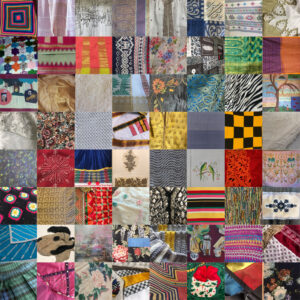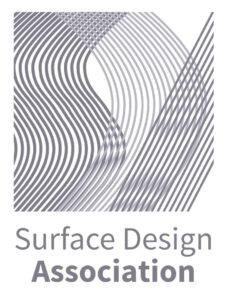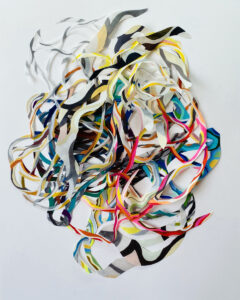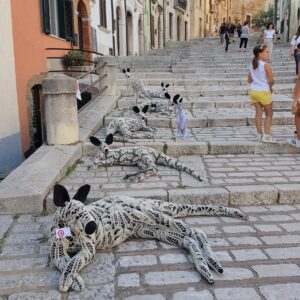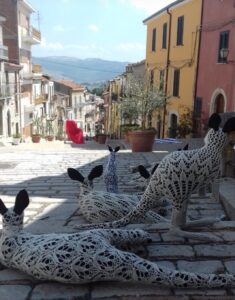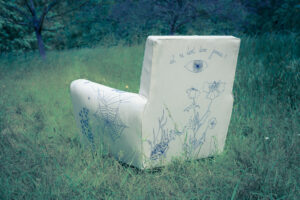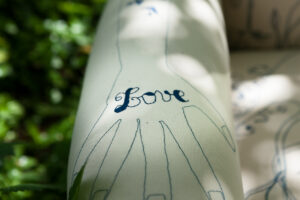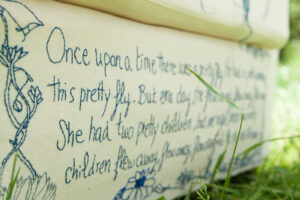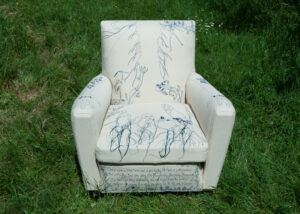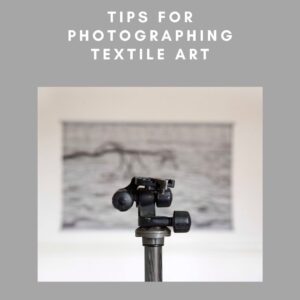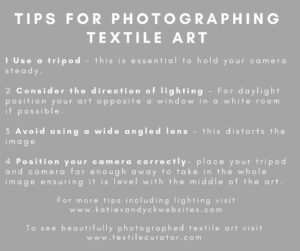May 4, 2020
In
Textile Art
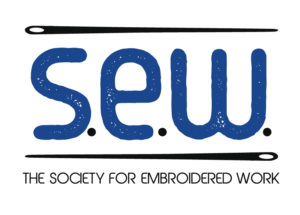


[Centre image: From left: Art by Cat Frampton, Emily Tull, Elizabeth Griffiths, Frances Palgrave, Sarah Gwyer, Kate Tume, Dr Jessica Grimm, Rowena Liley. Sculpture in foreground by Lou Baker. Dolly by Annie Taylor]
Cat Frampton and Emily Tull started S.E.W in 2018 to help promote and support artists who use stitch and show the art world that stitching is art. I couldn’t agree more, which is why I interviewed them to find out more.
What exactly is S.E.W?
S.E.W stands for Society For Embroidered Work, a society for artists who have a stitched element in their work. We were unaware of a Society for artists who stitched, there are for painters, graphic art…and also Guilds and various groups for textile artists but nothing for those who fall in-between the gaps, or don’t necessarily sit neatly in the description. Unfortunately still in these times it can be frowned upon if an artist has stitch in their work, and many artists can feel that they don’t fit into a category. Our member’s artwork cover a broad spectrum from traditional textiles to art in which concrete, bark, paint or household items are stitched into. The aim of S.E.W is to promote and support artists who have an element of stitching in their artworks, hand or machine and traditional or contemporary forms of embroidery but also to host exhibitions to show the art world that stitched art is art!
When and why did you start it?
S.E.W was started after we (Cat Frampton and Emily Tull) got chatting on Instagram, in 2018. We didn’t know each other well and had in fact never met, only connecting over a shared anger at being rejected from a couple of exhibitions, rejections that felt as if they were based in a misapprehension about embroidery. We both understood that rejection is a normal part of being an artist, but when no embroidery is selected for an ‘open’ exhibition, or there is not even a tick box on the exhibition submission form for your medium, it becomes frustratingly obvious that you are not working in a level playing field.
Stitched art is art, but being an artists who uses a needle in their work, you are constantly having to fight against the idea that it’s a lesser art form than, say, painting or sculpture. People have a weird perception of embroidery and the Society for Embroidered Work was born out of wanting to change that.
How many members do you currently have?
We currently stand at just over 460 members worldwide.
What are you looking for in members?
We are looking for members who take their work seriously. We don’t care about what stitches people use, what they stitch into, if the work is wholly stitched or only has a small stitched element, we don’t care if the artists is stitching into fabric or embedding embroidery into concrete.
What we are looking for is artists who have a clear vision and strong individual style. From established artists to beginners showing strong promise, we are looking for those that are making art using stitches.
If people are interested in applying to join how does it work?
We hold membership open calls. The submission required consists of good quality clear photographs – we want to see the art not the reflection in the glass of a frame. An artist’s statement, we want to learn what motivates and inspires you work, we are not concerned with grammar or spelling or pretentious waffle just that you see yourself as an artist making art. We also ask for social media and website links just in case we need to see more work.
Is someone is interested in applying to our next call out we just ask for them to really consider what images they put forward – do they really sum up your practice? Although we ask for web links we don’t look at everyone’s as there is a large number to go through and so first impressions really do count.
When is your next exhibition?
Our current exhibition plans have been shelved for the next few months. We did have a few things planned, but obviously, right now, exhibition planning is up in the air. We hope to have another excellent exhibition as soon as we possibly can.
To find out more visit www.societyforembroideredwork.com



